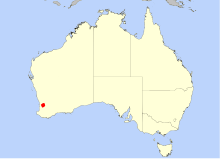Drosera silvicola
| Drosera silvicola | ||||||||||||
|---|---|---|---|---|---|---|---|---|---|---|---|---|

Drosera silvicola |
||||||||||||
| Systematics | ||||||||||||
|
||||||||||||
| Scientific name | ||||||||||||
| Drosera silvicola | ||||||||||||
| Lowrie & Carlquist |
Drosera silvicola is a carnivorous plant belonging to the genus sundew ( Drosera ). It belongs to the group of so-called dwarf sundews and is native to southwestern Australia.
description
Drosera silvicola is a perennial herbaceous plant . This dwarf sundew , which forms an open convex rosette of upright and semi-upright leaves, reaches a diameter of about 3 cm. The stem axis is 3 cm long and covered with the withered leaves of the preseason. You can often see support roots underneath.
The bud of the stipules is ovate, 8 mm long and 4 mm wide. The stipules themselves are 8 mm long and three-lobed. The middle lobe is divided into 3 segments.
The leaf blades are narrowly elliptical, up to 5.5 mm long and 1 mm wide. The leaf stalks are 9 mm long, 0.8 mm wide at the base and taper to 0.4 mm at the leaf blade. They are also fluted on the underside.
The flower stalk is up to 8 cm long and has tiny, bolt-shaped glandular hairs, the distribution of which increases towards the inflorescence. The inflorescence is a wrap of up to 20 flowers on approximately 1.5 mm long pedicels. The egg-shaped sepals are 2.8 mm long and 1.0 to 1.3 mm wide. The surface and the edges are occasionally covered with glands. The rose-colored petals are reddish at the base, irregularly serrated at the tip, 7 mm long and 5 mm wide.
The ovary is approximately circular, 0.5 mm long and 0.8 mm in diameter. The 3 red, horizontally stretched styluses are 0.5 mm long. The 1.5 mm long scars are translucent white and taper to a point at the end. Fruit and seeds are unknown.
The formation of brood scales is typical of dwarf sundews .
Distribution, habitat and status
Drosera silvicola occurs only on a small area in the extreme southwest of Australia. It thrives there mainly on laterite gravel in the open jarra forest 7 km south of North Bannister on the Albany Highway. The plant is only known within a radius of 2 km, but it is not threatened or endangered.
Systematics
The name "silvicola" comes from Latin and means "who lives in the forest" ("silva" = forest), which refers to the location of the plants. Drosera barbigera is considered the closest relative but differs in the shape of the flower stem and the shape and color of the flower.
literature
- Allen Lowrie, Sherwin Carlquist: Eight new taxa of Drosera from Australia. In: Phytologia. Vol. 73, No. 2, August 1992, ISSN 0031-9430 , pp. 98-116, here pp. 105-107 .
